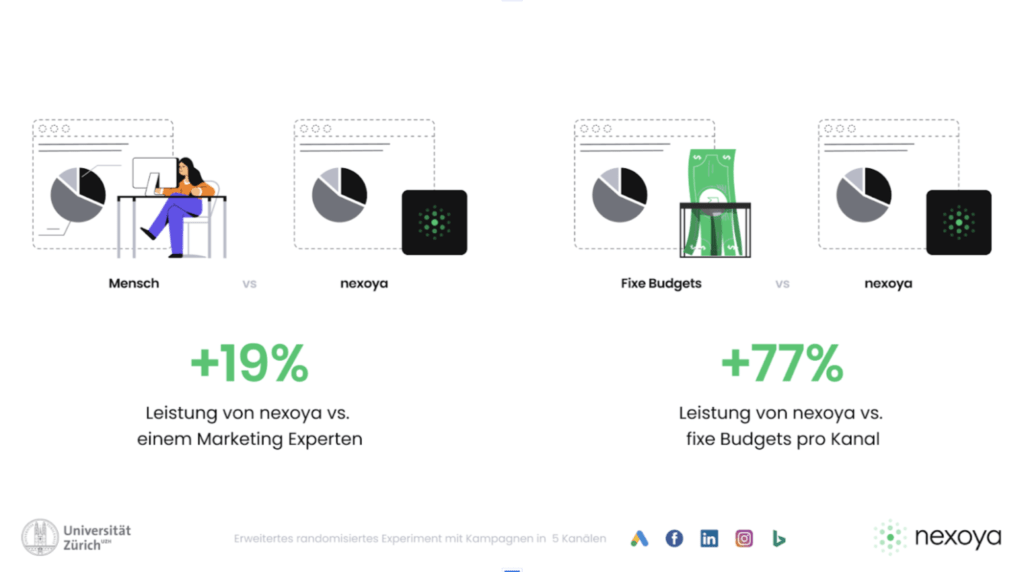Zurich and Berlin, February 10th, 2022 – Corona is driving people into digital channels. Here they encounter an increasingly personalized world, but one in which cookies and personalized tracking will soon be a thing of the past. The reason is more critical consumers and the upcoming tightening of data protection through the TTDSG and the EU’s ePrivacy Regulation. Marketing experts are increasingly turning to solutions that provide them with a less personalized and more statistical database. Meanwhile, business is struggling with shrinking budgets and looking for technical solutions to adapt to the new normal. AI applications are being used in more areas as a result, and their adoption is on the rise. Experts from Nexoya, a solution for AI-based marketing analytics, will present these and other trends for digital marketing against the backdrop of their experience and using practical examples.

Trend 1: More data and new requirements
Online applications and digital channels have seen a huge uptake since the pandemic began. This shift in consumer behavior creates more opportunities for automated experience elements. The Corona measures gave digital marketing an additional boost as the importance of digital and mobile touch-points continues to grow. Two years of pandemic have led to economic losses in many places. As a result, budgets have shrunk in many companies. The impact will continue to shape and change much beyond 2022. What is needed are solutions that help companies and their customers adapt to the new normal. Those responsible for digital marketing, for example, must compensate for fluctuating market conditions. Overall, there is a lot of cost pressure. “Marketing departments today have to do more with less budget. Agency budgets are shrinking; instead, efficient internal solutions for marketing are needed that require little manpower and can adapt quickly to changes,” says Marco Hochstrasser, CTO and co-founder of Nexoya.
Practical example: Holiday region relies on AI-based marketing
The pandemic has also changed expectations of leisure activities and tourist services. Lenzerheide Marketing und Support AG (LMS) markets the Lenzerheide vacation region. User and mobility behavior changed noticeably in the last two years. Due to hygiene and distancing regulations, visitor management now plays an important role, as booking guests should be distributed as evenly as possible among the villages and accommodations. In order to increase its own success rate, data from third-party providers, such as weather data, also became interesting for the LMS campaigns. In the spirit of data-driven management, LMS is now fully exploiting the potential of its marketing data – even to the point of overcoming the challenges posed by the pandemic. This is made possible by an AI-based approach to marketing analytics.
“Equipped in this way, we are able to assess future performance, optimize campaigns and ideally align budgets based on AI-based predictions”
Marc Schlüssel, CMO at Lenzerheide Marketing und Support AGFor example, optimizing budget allocation using an internal AI-based platform increases the performance of marketing KPIs by up to 77 percent compared to constant budgets. This is what a joint test series with the University of Zurich has shown. Compared to a human expert, it shows a 19 percent higher performance.
Trend 2: AI applications are catching on
The use of AI is increasingly associated with marketing automation, recommendations and personalized digital experiences. But also overall, the acceptance and knowledge of AI and machine learning is increasing in companies and in the general population. Deepfakes or chatbots illustrate the ability of AI to create lifelike experiences. Platform providers such as Google, Apple, Facebook or Amazon and martech providers such as Adobe, Salesforce or Oracle are making investments and innovations in AI worldwide. Marketers are already familiar with the technology, as it is often already in use in other areas of the business. As a result, the usage threshold is lowered, and know-how and trust are already available internally. Customers increasingly expect companies to align with their communication habits, to customize content, to play it out to specific target groups, and to offer suitable products. Personalization and engagement with a focus on long-term customers are becoming increasingly important in e-commerce. AI-based solutions help marketing teams meet these challenges and the high pressure to optimize.

Trend 3: Marketing without cookies, profiling and personal tracking
The new version of the Telecommunications Telemedia Data Protection Act (TTDSG) in Germany regulates, among other things, the protection of confidentiality and privacy when using websites. It is a good example of how the GDPR and the new ePrivacy Regulation are being translated into law. Against this backdrop, marketers are focusing more on channels and publishers that enable the context-oriented playout of marketing measures in a privacy-compliant manner. And they are focusing on technologies that provide them with a non-personalized and more statistical database for their data-driven decisions. Increasingly, they will be on the lookout for privacy-compliant attribution for multichannel campaigns.
“From a marketing analytics perspective, the TTDSG is in line with expectations, in that cookies, profiling, and personal tracking are not a meaningful and privacy-compliant means to play out marketing efforts. At nexoya, we have always used only statistical values when analyzing marketing KPIs to provide AI-driven recommendations to our customers. The metrics we use for this are based on the client’s systems and are completely unpersonalized,” explains Marco Hochstrasser. “These can be our own systems, such as SAP, but also publisher data, which we combine specifically to calculate the statistically based marketing analysis from it – a method that is fully compatible with the ePrivacy regulation, as no personalized data is used.”

Practical example: Swisscom integrates internal conversion data
An AI-based platform enables Swisscom AG to integrate internal conversion data for campaign optimization – while maintaining the highest level of data protection. The company did not want to combine data from third-party providers such as publishers – i.e. 3rd party data such as Google – with the company’s own data – for example first party data from Oracle – from its internal systems due to data protection concerns, especially in view of the upcoming ePrivacy regulation. Thanks to the integration of nexoya’s marketing analytics platform and the aggregation of data as well as prediction of campaigns from all digital channels, Swisscom is now able to get conversion-driven optimizations of their campaigns with little effort and adjust them automatically.
“nexoya allows us to integrate data from Oracle Eloqua and Adobe Analytics into the campaign optimization process to optimize campaigns on channels like Google. This gives the team more insights into the combined third-party data with the company’s own data and suggestions on how to optimally adjust the budget,” says Milos Radovic, Head of Marketing Development and Strategy at Swisscom.